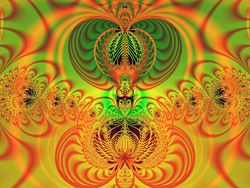A fractal is a mathematically generated design whose details resemble the original fractal, a property known as self-similarity. A fractal is produced with mathematical equations that undergo iteration or are recursive in form. The two leading computer programs for creating fractals are UltraFractal and Apophysis.

The fractal nature of some plants has convinced many people that God must have designed the natural world (see ferns). The leaves of a fern are shaped very much like the frond. Evolutionary biologists have yet to propose a satisfactory explanation for the spontaneous appearance of complex patterns in living organisms. They cannot adequately explain the evolutionary advantage of an endlessly repeating pattern and how it comes about from elementary biological or chemical processes.
- Fractals have been studied by mathematicians for over a century. The name was coined by Benoit Mandelbrot, a mathematician at Yale University. He calls fractals the "geometry of nature." [1]
Damien Jones wrote:
- A fractal is a shape that, when you look at a small part of it, has a similar (but not necessarily identical) appearance to the full shape. Take, for example, a rocky mountain. From a distance, you can see how rocky it is; up close, the surface is very similar. Little rocks have a similar bumpy surface to big rocks and to the overall mountain.[2]
References
External links
- Ask Dr. Universe - Washington State University
- Fractal fronds
- Fractals, in Layman's Terms
- UltraFractal
- Apophysis
